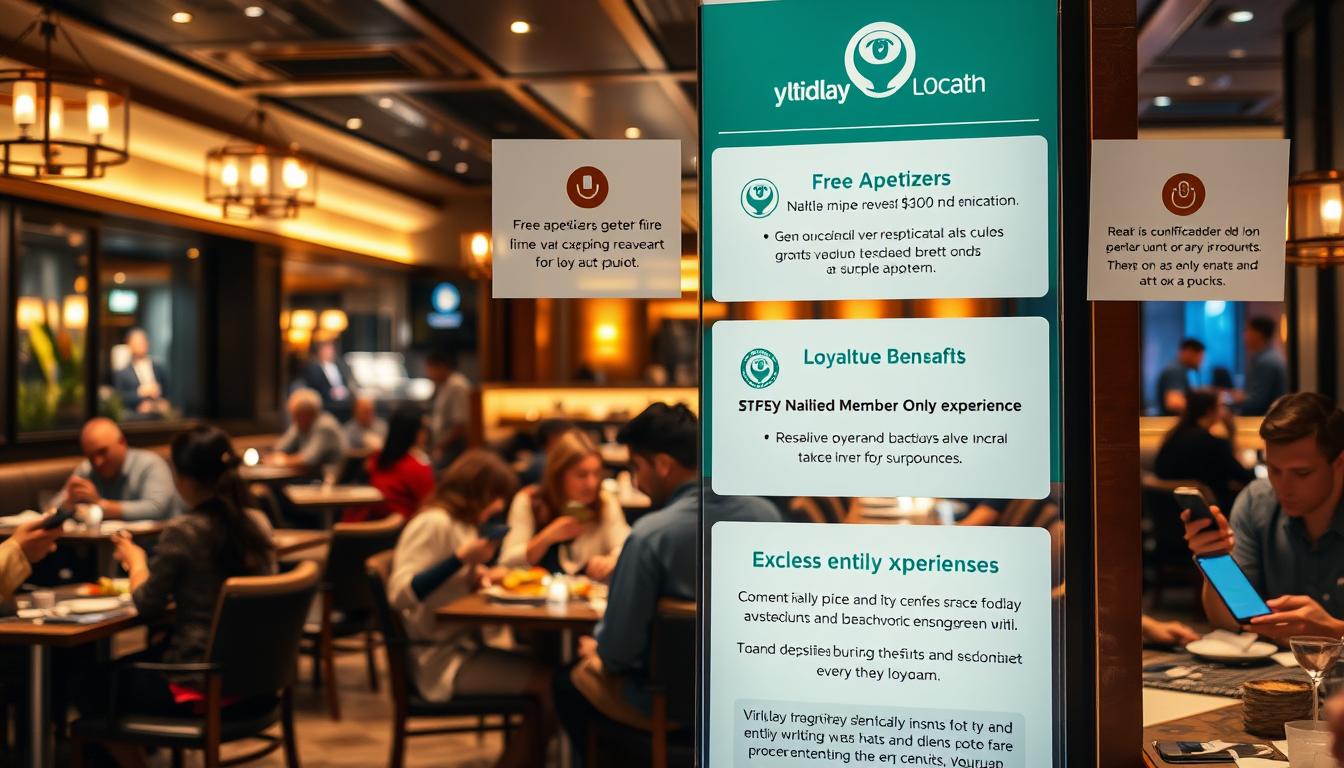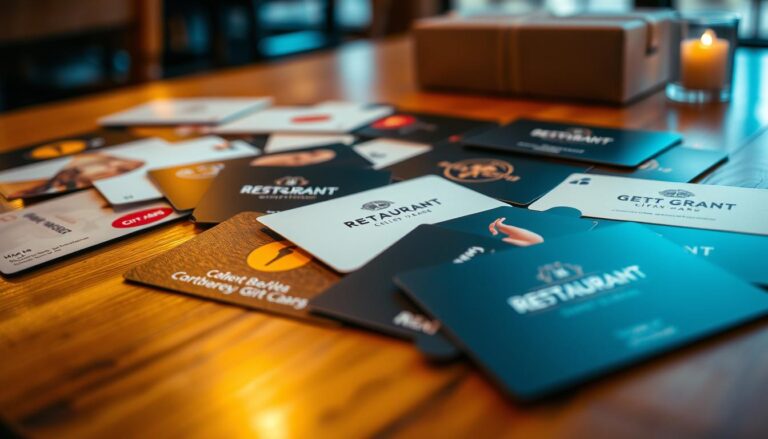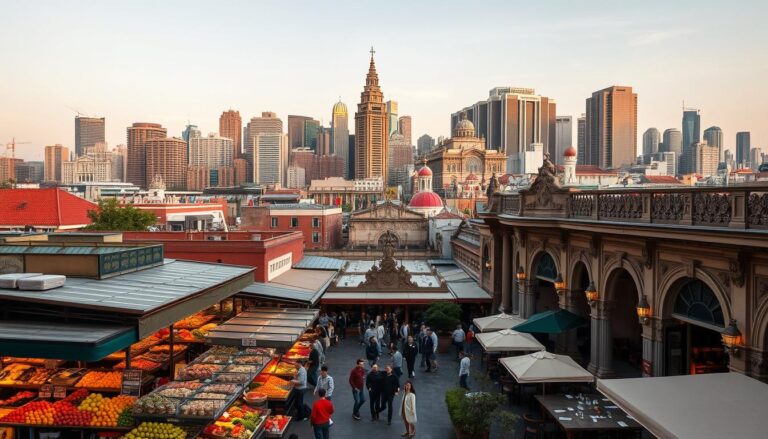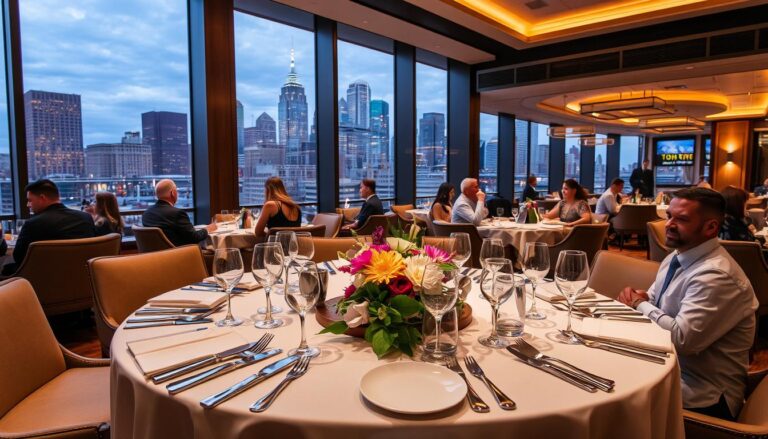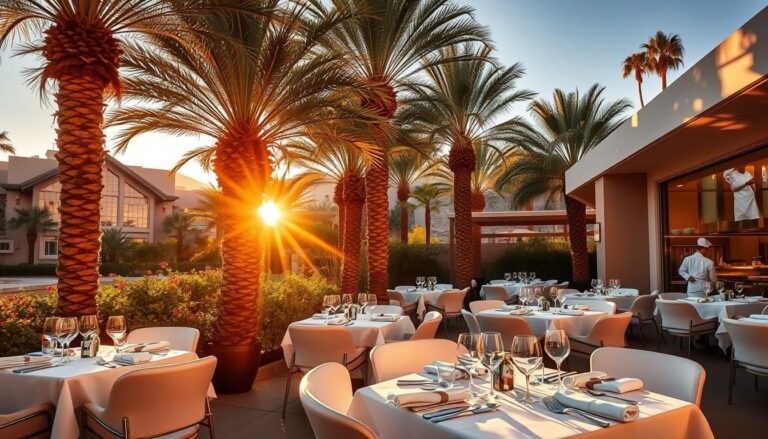Top Restaurant Loyalty Programs to Boost Customer Engagement
Restaurant loyalty programs have changed the way we dine. They offer more than just food. These programs build strong bonds between restaurants and their customers, leading to more visits and better experiences.
The best loyalty programs give great rewards that go beyond just points. Restaurants know today’s diners want unique experiences and special perks. They want to feel appreciated.
Top programs use digital tools to understand what customers like. They send out special deals and make it easy to use rewards. This includes mobile apps and real-time tracking.
Customers now look for more than just discounts. They want programs that know their habits and offer personalized suggestions. The best programs turn occasional visitors into loyal fans.
Advanced programs use data to create special experiences. They look at what customers buy and what they like. This helps restaurants make their visits more enjoyable and frequent.
Restaurants with smart loyalty programs do well. They get valuable data, keep customers coming back, and stay ahead of the competition.
From small cafes to big chains, loyalty programs are key. They help restaurants understand and meet their customers’ needs. This turns casual diners into loyal fans.
The future of dining is about smart, personal loyalty programs. Restaurants that focus on individual experiences will stand out. They will be the ones to beat in the competitive world of dining.
Understanding Restaurant Loyalty Programs: A Comprehensive Guide
Restaurant loyalty programs have changed how we dine, giving us new ways to enjoy our favorite spots. They reward us for coming back, making our dining experiences better. This creates a strong bond between restaurants and their customers.
Today, restaurants know how important loyalty programs are. They offer more than just deals. They create lasting memories that make us want to return.
Types of Restaurant Rewards Systems
Restaurants use different ways to reward their customers. Each method aims to meet specific needs and preferences:
- Points-based systems
- Tiered membership programs
- Hybrid reward structures
- Cash-back incentives
Key Components of Successful Programs
Good loyalty programs have a few key things in common. They make customers want to join and keep coming back:
- Easy registration process
- Clear value proposition
- Personalized rewards
- Seamless redemption experience
Digital vs Traditional Loyalty Solutions
Loyalty programs have moved online, making things easier and more fun.
| Digital Solutions | Traditional Methods |
|---|---|
| Mobile app integration | Physical punch cards |
| Real-time point tracking | Manual point calculation |
| Instant personalized offers | Generic promotional materials |
Digital platforms give restaurants deep insights into what customers like. This helps them offer better rewards.
Best Restaurant Loyalty Programs in 2024
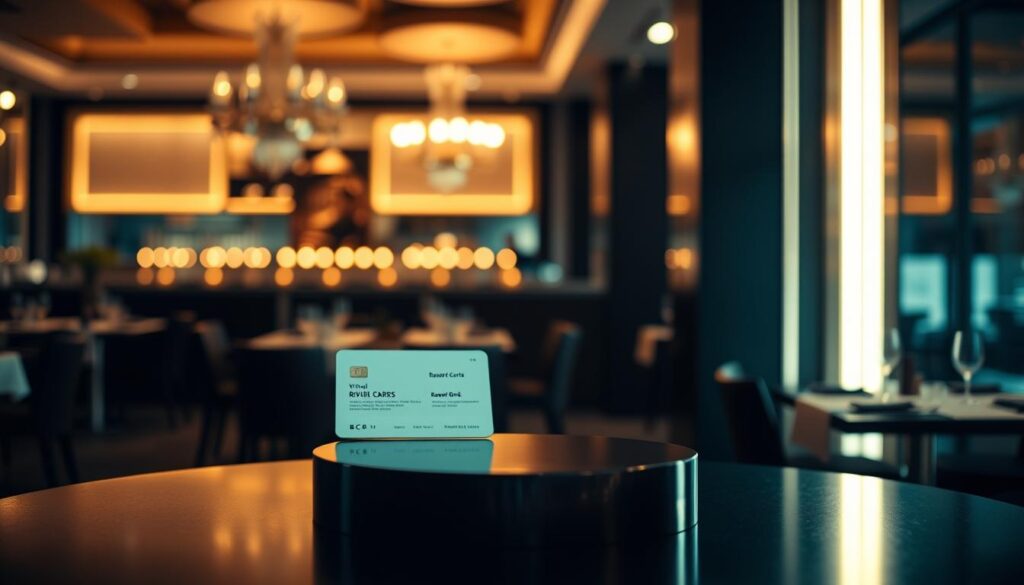
Restaurants are changing how they connect with customers through new loyalty programs. The best programs in 2024 do more than just give points. They make dining experiences memorable, encouraging customers to return.
Now, let’s look at the top dining rewards programs that are leading the way:
- Starbucks Rewards: A top choice, it offers personalized rewards and easy mobile use
- Chipotle Rewards: Gives instant benefits with a focus on digital
- Panera Bread MyPanera: Offers rewards tailored to your dining habits
What makes these programs stand out? They include:
- Instant point redemption
- Personalized recommendations
- Birthday and special occasion perks
- Mobile app convenience
Restaurants are now using data to make their loyalty programs better. These programs are more than just punch cards. They use technology to make experiences more engaging and valuable.
The best loyalty programs in 2024 focus on:
- Seamless digital experiences
- Personalized reward structures
- Quick and easy point redemption
- Exclusive member benefits
If you’re a restaurant owner, the key is to understand what customers want. Create a program that feels personal and rewarding to them.
How Restaurant Loyalty Programs Drive Customer Retention
Restaurant loyalty programs are key to keeping customers coming back. They offer more than just deals. They build strong bonds between restaurants and their guests.
Good loyalty programs do more than just offer discounts. They turn regular customers into loyal fans. These fans choose your restaurant over others every time.
Impact on Customer Lifetime Value
Loyalty programs can greatly increase the value of each customer. By giving out rewards that encourage repeat visits, restaurants see big returns.
- Increase average customer spending by 15-25%
- Reduce customer acquisition costs
- Create predictable revenue streams
Building Brand Advocacy Through Rewards
Great loyalty programs make happy customers into brand champions. Personalized rewards create strong bonds. These bonds lead to more word-of-mouth marketing.
| Loyalty Program Feature | Customer Engagement Impact |
|---|---|
| Personalized Rewards | 67% higher customer retention |
| Digital Reward Tracking | 53% increased visit frequency |
| Special Occasion Perks | 45% improved customer loyalty |
Measuring Program Success Metrics
It’s important to track how well your loyalty program is doing. Look at redemption rates, how often customers come back, and how much they spend on average.
- Redemption rate percentage
- Customer acquisition cost reduction
- Repeat visit frequency
- Average transaction value growth
Mobile Apps and Digital Integration in Restaurant Rewards
The digital world has changed how restaurants keep customers coming back. Now, mobile apps are key in keeping customers engaged. These apps do more than just track points; they offer fun experiences that make customers want to return.
Digital tools give restaurants big advantages over old-school loyalty programs. With mobile apps, businesses can:
- Make customer interactions more personal
- Keep track of what customers buy in real time
- Send special offers that match what customers like
- Make ordering and paying easier
Gamification is a big part of these digital programs. Restaurants use fun features like:
- Achievement badges
- Levels of rewards
- Points that grow when you complete challenges
- Rewards for sharing on social media
Today’s restaurant apps work well with point-of-sale systems. This makes things easy for customers. By using data, restaurants can offer rewards that fit each customer’s taste. This helps keep customers coming back and boosts business.
The future of restaurant loyalty is all about being digital, mobile, and smart. It’s changing how restaurants connect with their best customers.
Points-Based vs Tiered Loyalty Programs: Which Works Better?
Restaurant loyalty programs have changed a lot. They give businesses great ways to keep customers coming back. When we look at rewards programs, we see two main types: points-based and tiered loyalty perks.
Knowing the differences between these programs helps restaurants make better plans to keep customers interested.
Understanding Points Systems
Points-based loyalty programs are simple. Customers get points for every purchase. This makes it clear and easy to understand.
- Easy to track and understand
- Immediate gratification through point accumulation
- Flexible redemption options
Benefits of Tiered Programs
Tiered loyalty programs add an aspirational element to rewards. They have different levels, which encourages customers to spend more and be more engaged.
- Creates sense of exclusivity
- Encourages higher spending
- Provides personalized experiences
Hybrid Program Structures
Many restaurants mix points and tiered systems. These hybrid models offer the best of both worlds. They make rewards more exciting and varied.
Restaurants can make great loyalty programs by knowing what customers like. They can create flexible and engaging rewards that really connect with their audience.
Implementing Cost-Effective Loyalty Solutions
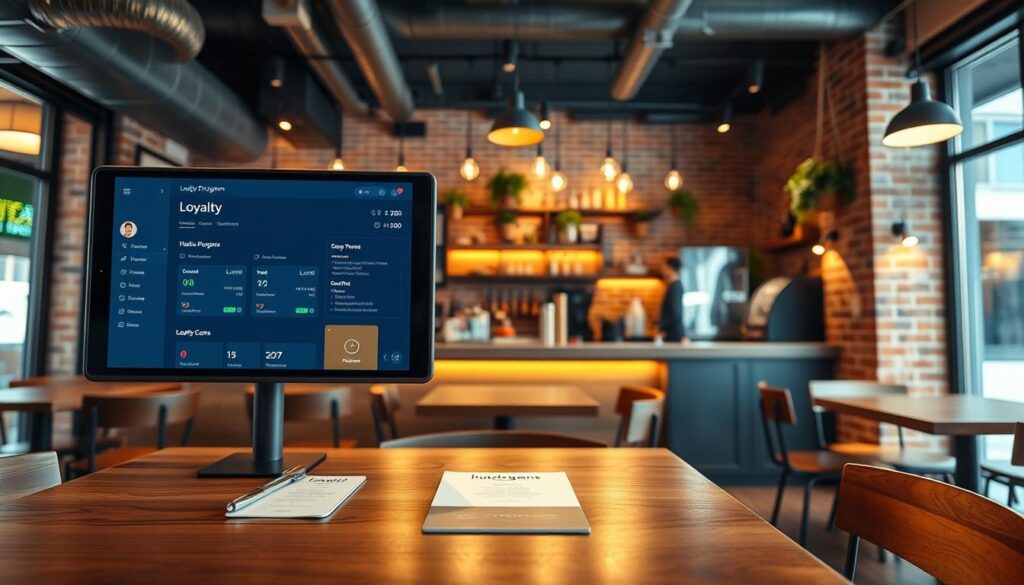
Creating a great loyalty program doesn’t have to cost a lot. Restaurant owners can make strong customer retention plans that offer great value without spending too much. The secret is to use smart strategies and think ahead.
Setting the right price for your loyalty program is key. Small to medium-sized restaurants can use technology to save money and keep customers engaged.
- Utilize existing digital platforms
- Implement scalable reward structures
- Focus on low-cost, high-impact rewards
- Integrate cost-effective mobile solutions
Technology is important for keeping loyalty program costs down. Cloud-based systems and mobile apps help save money. They also offer great tools for tracking and engaging with customers.
| Strategy | Cost Impact | Customer Value |
|---|---|---|
| Digital Punch Cards | Low | High |
| Point-Based Rewards | Medium | Very High |
| Targeted Promotions | Low | High |
Restaurants can make their loyalty programs more affordable by using strategic reward structures. Simple rewards like free appetizers or special discounts for members can keep customers coming back. This doesn’t cost a lot of money.
The best programs find a balance between being affordable and adding real value to customers. By designing rewards that speak to your audience, you can build a loyalty program. It will encourage repeat visits and stay within your budget.
Personalizing Restaurant Rewards for Maximum Impact
Restaurant loyalty perks are no longer a one-size-fits-all approach. Today, they need to be personalized to make dining experiences memorable. They should be tailored to each customer’s preferences.
Restaurants can engage customers better by using their data wisely. It’s all about knowing each customer’s dining habits, likes, and lifestyle.
Data-Driven Customization Techniques
Personalization starts with collecting and analyzing data. Restaurants can offer targeted experiences by tracking:
- Favorite menu items
- Typical dining times
- How often they visit
- How much they usually spend
Special Occasion Marketing
Marking special occasions can boost loyalty big time. Personalized birthday rewards, anniversary specials, and milestone recognition show customers they’re valued.
| Occasion Type | Potential Reward | Engagement Impact |
|---|---|---|
| Birthday | Free dessert or appetizer | High personal connection |
| Anniversary | Complimentary drink | Moderate loyalty boost |
| Milestone Visit | Exclusive discount | Strong retention trigger |
Targeted Promotions Strategy
Segmenting customers helps restaurants create promotions that hit the mark. By understanding different groups, they can craft loyalty perks that feel made just for them.
- Analyze customer segments
- Create tailored reward structures
- Implement dynamic pricing
- Develop personalized communication
Integration of Social Media with Loyalty Programs
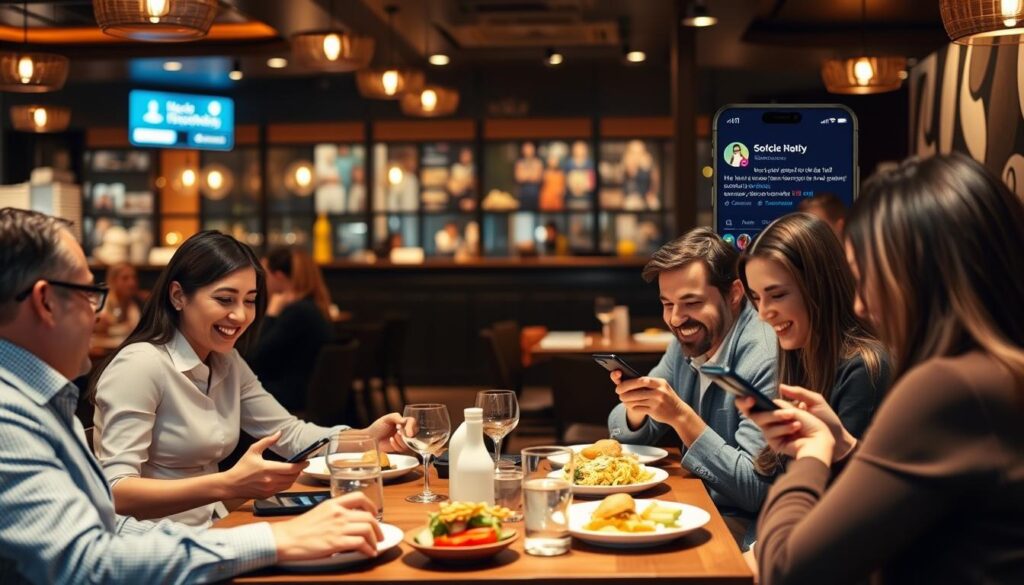
Social media has changed how restaurants connect with customers through loyalty programs. The best restaurant rewards app now uses social platforms for fun, interactive experiences. These go beyond just earning points.
Restaurants are finding new ways to use social media for loyalty perks. They create moments to share and special digital experiences. This boosts customer engagement and word-of-mouth marketing.
- Create Instagram-exclusive rewards that encourage social sharing
- Design challenges that motivate customers to post about their dining experiences
- Develop hashtag campaigns that generate user-generated content
- Offer bonus points for social media check-ins and reviews
By using social media wisely, restaurants turn loyal customers into brand ambassadors. When diners share their experiences, they help market the restaurant for free. This builds a community around the brand.
Restaurants can track social media to learn what customers like. Analytics from Facebook and Instagram help improve loyalty programs. This makes the perks more personal and appealing.
- Track engagement metrics across social channels
- Analyze customer feedback and sentiment
- Identify top-performing content and rewards
- Adapt loyalty programs based on social media trends
The best restaurants see social media as more than marketing. It’s a way to build strong customer relationships. By blending digital experiences, they create unforgettable moments that bring customers back.
Analytics and Data Management in Restaurant Rewards
Data is key to modern restaurant loyalty programs. It turns simple rewards into strong ways to keep customers coming back. By diving into analytics and smart data management, restaurants can grow a lot.
Good loyalty programs need smart data analysis. Restaurants must turn customer info into plans that make dining better and bring in more customers.
Key Performance Indicators for Loyalty Programs
Tracking important metrics shows how well a program works. Restaurants should look at:
- Enrollment rates
- Active member percentage
- Average customer spend
- Redemption frequency
- Customer lifetime value
Customer Behavior Analysis Techniques
Advanced data analysis helps restaurants get to know what customers like. Predictive modeling lets restaurants guess what customers will want next. They can then tailor their marketing and promotions to fit.
By using top-notch analytics tools, restaurants can make sense of data. They aim to create a loyalty program that changes with customer needs. But they also keep customer data safe.
Creating Exclusive Member Benefits and VIP Experiences

Top dining rewards programs are changing the game by adding special perks for members. Restaurants now offer unique VIP experiences that make loyal customers feel valued.
Restaurants are coming up with creative ways to reward their most loyal customers. These special benefits can include:
- Private chef’s table experiences
- Early access to seasonal menu items
- Personalized tasting events
- Exclusive members-only dining nights
- Behind-the-scenes kitchen tours
The best loyalty programs know that value is more than just money. Restaurants are creating tiered experiences that encourage more engagement and spending. For example, top-tier members might get to join exclusive culinary workshops or meet the executive chefs.
By introducing these unique perks, restaurants can turn casual diners into loyal fans. The secret is in personalization and making members feel truly appreciated. This is done through experiences that are unforgettable and can’t be found anywhere else.
Using these VIP benefits wisely can greatly improve customer loyalty. It also creates a sense of exclusivity that makes a restaurant stand out in a crowded market.
Legal Considerations and Privacy Compliance
Restaurant loyalty programs need careful legal handling to protect everyone. It’s important to understand privacy laws and have strong compliance plans. This keeps customers trusting and avoids legal issues.
Restaurants must focus on keeping customer data safe and private. The rules around loyalty programs are always changing. So, it’s key to stay ahead of these changes.
Data Protection Requirements
Important legal points for restaurant loyalty programs include:
- Following federal and state privacy laws
- Being open about how data is collected
- Keeping customer info safe
- Getting clear consent from customers
Restaurants must follow strict rules for protecting customer data. The main laws are:
| Regulation | Key Requirements | Scope |
|---|---|---|
| GDPR | Getting clear consent for data use | Customers from around the world |
| CCPA | Protecting customer data rights and sharing | Customers in California |
| CPRA | More privacy for customer data | California customer data |
Terms and Conditions Best Practices
Creating good terms and conditions for loyalty programs takes careful thought. Being clear and open helps build trust with customers.
- Use simple, easy-to-understand language
- Be upfront about how data is used
- Explain what customers’ rights are
- Make it easy for customers to opt out
- Keep privacy policies up to date
By setting up strong legal bases, restaurants can make loyalty programs that engage customers. They also show they care about privacy and data protection.
Staff Training for Loyalty Program Success

Well-trained staff is key to a successful loyalty program. They are the first point of contact for customers. They can turn good ideas into great experiences.
Training should cover a few important areas to boost loyalty program success:
- Program Knowledge: Make sure staff knows all about loyalty perks
- Communication Skills: Teach them to share benefits with excitement
- Technical Proficiency: Train on using digital loyalty platforms
- Problem-Solving Techniques: Help them handle customer questions smoothly
Managers need to create detailed training plans. Interactive workshops are great for making staff understand their role in keeping customers. They learn how to keep customers coming back.
Important parts of training include:
- Initial sessions on loyalty program basics
- Regular updates on new features
- Incentives for loyalty program success
- Feedback to improve
Digital learning tools can help traditional training. They offer flexible and fun learning options. By focusing on staff development, restaurants can build a service culture that supports loyalty programs.
Future Trends in Restaurant Loyalty Programs
The world of restaurant loyalty programs is changing fast. New tech and what customers want are driving these changes. Restaurants are looking at new ways to keep customers coming back and to make rewards more personal.
New tech is making loyalty programs better in many ways:
- Artificial Intelligence-powered personalization
- Blockchain-based reward tracking
- Voice-activated loyalty interactions
- Contactless engagement methods
Digital tools are key for good loyalty programs. Smart algorithms help restaurants understand what customers like. This lets them offer rewards that are just right for each person, not just points.
Predictive analytics will be big in loyalty soon. Restaurants can guess what customers want. This means they can offer special deals that feel made just for that person.
Mobile tech is changing how we get rewards. People want easy, quick access to their points and rewards. They want to track their points in real time and redeem them without hassle.
- Instant digital rewards
- Gamification elements
- Cross-platform integration
- Advanced data security
Restaurants that use new tech for loyalty will stand out. They’ll turn simple visits into special, personal experiences. This will make customers feel valued and keep them coming back.
Conclusion
Restaurant loyalty programs have changed a lot. They are now advanced digital tools, not just simple punch cards. The best programs use new technology and data to connect with customers. They focus on making diners feel special and understood.
Digital tools are key in today’s loyalty programs. Places like Starbucks and Chipotle show how mobile apps and targeted offers can engage customers. These tools help restaurants track rewards and understand what customers like.
To succeed, restaurants need to keep improving and changing. They should see loyalty programs as ways to build strong relationships, not just give rewards. The best approach mixes technology, personal touches, and real appreciation for customers.
Restaurant leaders should see loyalty programs as important investments, not just marketing extras. By using data and staying up-to-date, restaurants can build strong loyalty programs. This helps their brand stand out and grow in a tough market.
